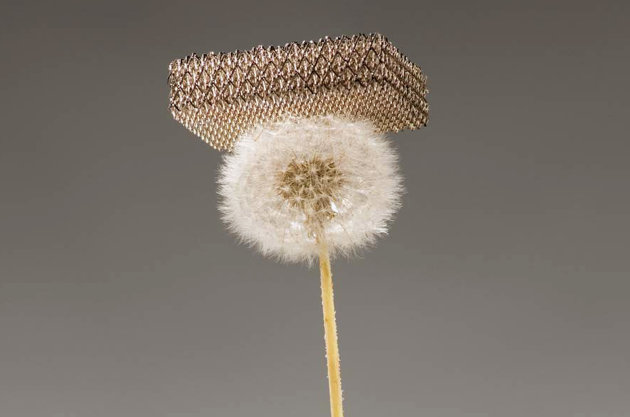
Posted on 11/19/2011 3:40:31 PM PST by Ancient Drive
A metallic lattice of hair-thin pipes is now the lightest solid yet created — less dense than air, scientists revealed. The strategy used to create these intricate structures could lead to revolutionary materials of extraordinary strength and lightness, including ones made of diamond, researchers added. Ultra-lightweight materials such as foams are widely used in thermal insulation and to dampen sounds, vibrations and shocks.
(Excerpt) Read more at news.yahoo.com ...

This can’t be! Obama said we are lazy. How can we invent something new?
If you heat it, will it rise up?
The Current FReepathon Pays For The Current Quarters Expenses?

OK OK, I just have to post this. Forget the technology here....it’s awesome; jaw-dropping. Uber cool.
I first heard about it earlier today via email from The Blaze, one of Glenn Beck’s Web sites. Let me just say this as kindly as I can. Their article must have been written, then edited, by a couple of third-graders. Syntax, spelling, structure were a mess. It was embarrassing to read.
I say this as a huge Glenn Beck fan, by the way.

Welcome to The Diamond Age
So is lighter than air solids possible?, What if you sprayed expanding foam insulation into a helium balloon? Would it absorb the helium when it expanded and solidified?
You wouldn’t heat it, you would enclose it in a thin-walled chamber and evacuate the chamber. If the material is strong enough to stay lighter than air under the atmospheric compression, then it must float in air. This is an idea I’ve often contemplated.
cool!
if it is lighter than air, why is it sitting on top of the dandilion and not floating away?
It’s permeated with air. You have to assume that the designation, “lighter than air”, means that the solid material weighs less than the air occupied by the space of the lattice structure, but this space is still mostly filled with air. Hence my remark about forming a “vacuum balloon” held up by this material.
They’re counting the density as the enclosed volume, not as the individual elements making it up. A frame made of thread might be less dense than air (1kg/m^3) but the thread still sinks in air.
Let us for a moment take the definition of “lighter than air” to mean “less mass per unit volume than air;” therefore by definition less dense. Then of course any object such as the ones under discussion here are not “lighter than air.”
The objects under discussion are of course mostly air. But the small proportion of their volume that’s not air (a solid such as metal) displaces that volume with something denser (namely, the solid).
Thus, any such structure must be denser than air.
Now I think you’re onto the definition that they’re using in the article: Namely, that the object is “lighter than air” meaning “less dense than air” so long as the object is not filled with air—that is, the object is in a vacuum.
What would happen if you released one of these objects from orbit? Might it gradually slow down due to aerobraking, but nevertheless come to float at some altitude above most of the atmosphere? I don’t think so, but it might take a very long time to come to earth.
The question hinges on what is meant by “volume”. In particular, does that volume include or exclude the large empty space between the metal parts? It’s crucially important because the dead volume is such an overwhelming majority of the total volume.
To answer your other question, no, it wouldn’t float because buoyancy needs the density of the surrounding in order to work. Up in space, the local air pressure is so low that it becomes much harder to be buoyant in it. Note that the object is full of holes, so whatever the external pressure is, will also be the internal pressure in the dead volume. The only difference is the (tiny) mass brought by the frame, which however will always add. In order to find some medium that this thing will be buoant in, you have to come up with a surrounding density that is greater than the metal itself (>>water, unless of course you don’t let the bubbles out). So the claim for “density” of this thing is somewhat misleading. At least in the case of styrofoam the dead space is sealed, so its mass/volume doesn’t change with air pressure or air composition so much.

Disclaimer: Opinions posted on Free Republic are those of the individual posters and do not necessarily represent the opinion of Free Republic or its management. All materials posted herein are protected by copyright law and the exemption for fair use of copyrighted works.